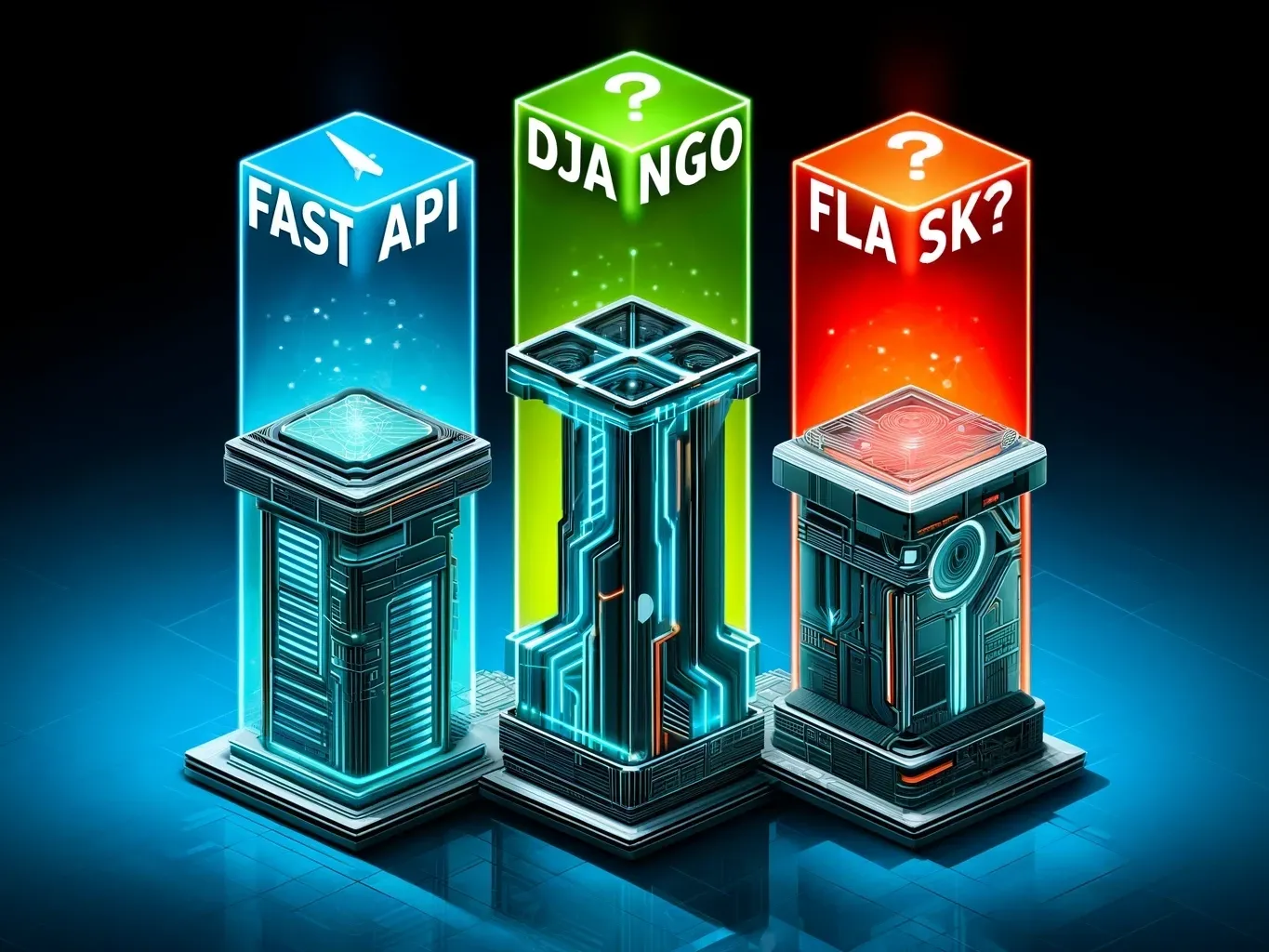
One of the most common questions for a Python web developer is "which framework should I use - Flask, FastAPI or Django?" Here is my own take on the strengths and weaknesses of each framework. But before I dive into my perspective, let's start with an overview of each framework.
Flask
Flask is a lightweight, "microframework" for Python web development. It's designed to be simple and extensible, making it easy to get a basic web app or API up and running quickly. Flask doesn't include many features out of the box, but has a large ecosystem of extensions for adding functionality.
FastAPI
FastAPI is a modern, fast (high-performance), web framework for building APIs with Python 3.6+ based on standard Python type hints. It leverages Python's async capabilities for high concurrency and includes automatic API documentation, input validation, and more.
Django
Django is a high-level, "batteries-included" Python web framework that encourages rapid development and clean, pragmatic design. It includes a wide range of built-in features like an ORM, authentication system, admin interface, and more, and has a large, mature ecosystem of packages and tools.
Their history
Flask was created by Armin Ronacher in 2010 as a simpler alternative to frameworks like Django. It quickly gained popularity for its minimalism and flexibility.
FastAPI, on the other hand, is a much newer framework. It was created by Sebastián Ramírez in 2018, aiming to bring together Python's async capabilities, static typing, and API documentation into one powerful tool.
Django has the longest history of the three, dating back to 2003. It was created by Adrian Holovaty and Simon Willison at the Lawrence Journal-World newspaper, and released as open source in 2005. Django has since become one of the most popular and fully-featured Python web frameworks.
Their features
| Feature | Flask | FastAPI | Django |
|---|---|---|---|
| Async support | No | Yes | Partial (with ASGI) |
| API documentation | Add-on (e.g., Flask-Swagger) | Automatic (Swagger/ReDoc) | Add-on (e.g., Django REST Swagger) |
| Database ORM | Add-on (e.g., Flask-SQLAlchemy) | Add-on (e.g., SQLAlchemy, Tortoise ORM) | Built-in |
| Admin interface | Add-on (e.g., Flask-Admin) | No built-in support | Built-in |
| Authentication | Add-on (e.g., Flask-Login) | Add-on (e.g., OAuth2, JWT) | Built-in |
| Type hints & validation | No built-in support | Yes (Pydantic) | Partial (in forms and models) |
So, which one?
When I'm working on a small, simple web app or API and I need to move fast, Flask is usually my go-to. Its lightweight nature lets me start coding immediately. I can have a basic prototype or MVP up and running in hours, not days.
The catch is that Flask makes you assemble all the other pieces yourself - databases, authentication, caching, etc. That's fine for tiny projects, but it quickly turns into a major chore once you need those features. The Flask library ecosystem can also feel a bit fragmented, with key packages sometimes abandonware. Still, for small, simple projects, Flask is hard to beat.
For example, if I'm building a simple REST API for a small dataset or a basic CRUD app for a single database table, Flask is perfect.
However, if I'm building more complex, high-performance REST APIs or async microservices, I've been reaching for FastAPI more and more. FastAPI leverages Python's async-first approach for screaming fast performance right out of the box. For high-throughput, low-latency services, it's a major win. Secondly, it uses Python type hints to automatically generate interactive API documentation. This is a huge timesaver and keeps docs in sync with code. Lastly, FastAPI's Pydantic library enables static typing and runtime validation of request/response data, which catches bugs early and makes refactoring a lot safer.
The main downside of FastAPI is that it's opinionated about using an async style and async-focused libraries, which have a steeper learning curve. I've found myself fighting against FastAPI's bespoke dependency injection system too. But for new, high-performance Python APIs, FastAPI is usually my first choice now.
For example, say you are building a real-time analytics API that ingests high-velocity sensor data and serves aggregated results to a monitoring dashboard. FastAPI's performance and concurrency features really shone.
Still, when I'm building large, full-featured web applications with lots of CRUD, relational data, and built-in admin features, Django is the way to go. With Django, I spend way less time wrestling with integrating and configuring dozens of libraries.
Its "batteries-included" approach and mature ecosystem save me countless hours of integration and configuration work. This let me focus on writing my core application logic, not plumbing and yak shaving. The initial learning curve is steeper, but Django's architecture, conventions and documentation are so complete and consistent that it will pay off very quickly.
In particular, Django's built-in ORM, authentication system, automatic admin interface and migration management are massive productivity multipliers. And the Django REST Framework is the gold standard for powerful, customizable API creation in Python. Yes, Django is a larger, more opinionated framework - but for large, full-featured web apps, I believe that's a strength, not a weakness.
If you are building a complex, multi-tenant SaaS application with role-based access control, reporting, an admin portal, and both REST and GraphQL APIs, Django is the way to go if you are trying to deliver this large project on a tight deadline.
| Frameworks | Flask | FastAPI | Django |
|---|---|---|---|
| Strengths | - Lightweight and minimalistic |
- High performance with async-first approach |
- Batteries-included approach with a mature ecosystem |
| Weaknesses | - Requires assembling additional components (databases, authentication, caching, etc.) |
- Opinionated about using async style and libraries, which have a steeper learning curve |
- Steeper initial learning curve |
| Example Use Cases | - Simple REST API for a small dataset |
- Real-time analytics API ingesting high-velocity sensor data and serving aggregated results to a monitoring dashboard |
- Complex, multi-tenant SaaS application with role-based access control, reporting, an admin portal, and both REST and GraphQL APIs, delivered on a tight deadline |
Conclusion
In the end, I don't believe there's one universally "best" Python web framework for every situation. The "best" web framework depends on your application's specific needs and your team's skills and preferences.
For total beginners or students, Flask is the best way to learn web dev fundamentals without too many abstractions. For high-performance, async Python services, FastAPI is a killer choice. And for large, full-featured web apps with lots of CRUD and relational data, Django is unbeaten.
As someone once put it: "To each their own, there's no one-size-fits-all solution." The good news is that you really can't go too wrong with any of these frameworks. They're all mature, powerful tools with devoted communities behind them. My advice: pick the one that feels the most natural for your use case and dive in. The real learning comes from building something real - pick the one that best aligns with your use case and dive in!

Written by Alissa Nguyen
FollowAlissa Nguyen is a software engineer with main focus is on building better software with latest technologies and frameworks such as Remix, React, and TailwindCSS. She is currently working on some side projects, exploring her hobbies, and living with her two kitties.
Learn more about me